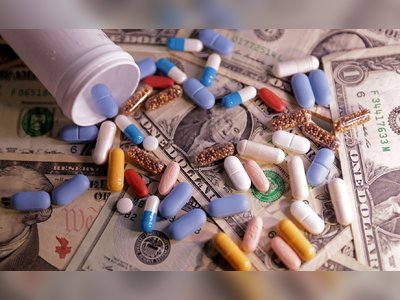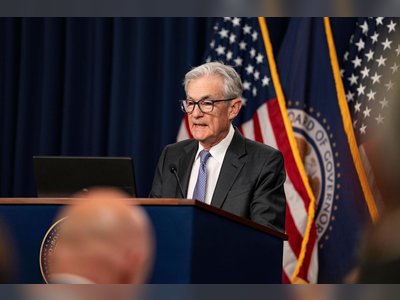
Covid’s endgame
The Pfizer vaccine’s approval by UK regulators marked what many hope is the beginning of the end of the coronavirus crisis. That was certainly the impression Boris Johnson was keen to convey during his Downing Street press conference on Wednesday.
The Prime Minister, however, warned the British people to avoid being overly optimistic. Deputy chief medical officer professor Jonathan Van-Tam went even further: ‘I don’t think we’re going to eradicate coronavirus,’ he said, ‘I think it’s going to be with humankind forever.’
If professor Van-Tam is correct, what can we expect to happen in our battle against the virus in the coming weeks and months? To answer such a question, it is first worth re-examining how the situation has looked a few months ago and just how quickly things can change.
In September, I wrote in The Spectator that slow exponential growth of the kind we were then seeing in Europe would have very serious consequences if left unchecked. Sadly, this proved to be the case. At that time, there were only around 20 coronavirus deaths a day in France. I sounded the alarm that we would likely see those numbers ‘creeping up’.
Since then, there have been 22,000 more French coronavirus deaths, peaking at an average of around 600 per day. It now seems very likely that France’s second wave deaths will exceed those of the first.
But it was not only France that I warned was creeping slowly into dangerous territory. As we know, when coronavirus rips through the societies of our European neighbours, it does not take long for the same thing to happen here.
Indeed, at the very start of October, I warned in The Spectator that hospitals in the north west were heading towards a very bad place. Then, the number of patients in hospitals with Covid-19 had risen from 77 to 612 in just five weeks.
Why was this so frightening? Because, just like France, the data showed that we were experiencing slow but steady exponential growth. I wrote that, without action, the first wave peak of 2,890 occupied beds in the north west could be exceeded in a similar timescale. The previous record was broken on 9 November — thankfully the numbers have now started to fall.
But the point is just how quickly things can change. When it comes to coronavirus, situations that appear quite rosy can very quickly spiral out of control. At the start of September, for instance, the idea of a second wave just a few weeks later, seemed fanciful to many. And yet that is where exponential growth gets you. Until we see vaccines entering millions of bloodstreams, we cannot afford to forget this lesson.
In the short term, there is cause for optimism, though. Why? Because the second national lockdown has clearly worked. It is worth noting, too, that with schools and universities open, it worked perhaps even better than we might have hoped.
The Imperial College React study published on Monday estimated that during lockdown the R-value — the rate at which the virus grows — has fallen to 0.71. There is some uncertainty associated with this figure, due to the inherent randomness of statistical sampling. However, the R-value is roughly consistent with current trends in case data, which show a 25 to 30 per cent weekly fall.
One slight note of caution is that hospitalisations are not currently falling at such a large rate, which may indicate that the drop has been in the less vulnerable younger age groups. Overall, however, this is exactly the kind of decline we would hope to see.
here has been some suggestion that infections were flattening (or even falling slightly in some regions) as a result of the tier system and that the second lockdown was, therefore, unnecessary. But such academic discussion misses the point. Why? Because achieving an R-value of 1.0 — at which point the infection rate flattens — means that things stay the same.
If the number of infections stayed the same, this would result in more than 400 deaths a day, amounting to 12,000 deaths a month, until we started to see large scale vaccine rollout. There is no doubt hospitals would struggle to cope — especially given the fact that we are entering what are traditionally the most difficult months for the NHS, winter flu season.
Even the virus falling to an R-value of 0.9 only leads to a very slow decline. In late October, even bearing in mind the economic hit and other awful consequences of lockdown, it was clear that the situation needed to be markedly improved.
So, after a month of lockdown, where are we at today? Fortunately, the phenomenon of exponential change is currently on our side — for now, at least, infections are falling.
It is reasonable to assume that a roughly fixed level of lockdown will lead to a fall in cases by a similar multiplying factor each week. What’s more, because of the delays between people becoming infected and testing positive, this effect should continue to be seen in case numbers for a week or so after the national lockdown was lifted in England. We might, therefore, expect case numbers in England to be around 10,000 by 9 December or so.
Finally, because of the significant lag between infections and reports of deaths, we should soon start to see a sustained fall in daily death numbers in England. Based on the fall in cases, we might expect the average daily UK Covid-19 death numbers to be around 200 by Christmas, a significant drop from recent peak levels.
Of course, that does not mean that the UK’s coronavirus story is over. Quite the opposite, in fact. For 10,000 new cases per day would only take us back to the levels of late September, not the three-figure values seen during the summer.
We know from the recent data in Wales that a reduction in infections resulting from lockdown can rapidly be reversed when the country opens up. Just as there is no point in paying for liposuction if you immediately return to your old bad dietary habits afterwards, we all need to hope now that the new tier system in England is effective, given the undisputed negative economic and mental health impacts of such restrictions.
The example of Liverpool provides cause for optimism. Here, cases were falling under the old Tier 3. (Though it is possible that the peak and the decline are exaggerated due to student cases at the start of term.) And, while an R-value of 0.9 is not sufficiently helpful when the virus is at a very high prevalence in the community, when the case numbers are low, it does lead to continued exponential decay, albeit at a slower rate than under full lockdown.
If the country, therefore, can keep the virus growth at 0.9 or lower — on top of a relatively low number of overall cases — then this should continue to reduce the pressure on hospitals, which remains the main justification for government intervention.
In the coming months, the government will need to balance two competing concerns: the desire to focus the most stringent measures on only those areas with the worst outbreaks — and the need to avoid confusion by imposing different rules on neighbouring areas, which can lead to a drop in compliance.
But it is not just a question of tiers keeping the virus in check. The claim from Sage that cases could double over Christmas sounds extreme, but it is not totally implausible. We know the virus can rekindle quickly. Remember, for instance, how many figures in American politics, including Donald Trump, contracted the virus at a relatively brief outdoor event in the White House gardens.
It is, therefore, not unreasonable to imagine that an infected person spending hours or days indoors at close quarters with a large family group could unknowingly trigger a wave of onward infections.
Given that we know the extremely high risk of coronavirus for the old (ONS data shows that of all coronavirus deaths, 75 per cent of them are among those aged 75 and over) and the relatively high infection numbers among the young, bringing the different generations together is a grave risk.
Just as the early experience of Italy could have given us information on how to mitigate the first wave back in March, it would be wise to watch the coming two weeks of data from America to see if there is a ‘Thanksgiving spike’. This would give us some insight into what kind of effect Christmas socialising may have here, and to modify our plans accordingly.
It is worth bearing in mind, however, that it is not always easy to attribute changes in numbers to a single root cause. (Arguments, for example, concerning the relative impact on UK infections from the Eat Out to Help Out scheme and of foreign holidays are far from settled.)
One particular danger of Christmas is university students — and the possibility that many could be returning home having had false-negative tests. Institutions are currently using rapid tests to screen all students before they go home. Of course, there are benefits to detecting infected students and requiring them to quarantine.
But while there has been intense discussion of the fact that PCR tests for coronavirus can produce false-positive results (albeit at an exceptionally low level) there has been much less attention paid to the effect of false negatives. These occur when someone with the disease wrongly tests negative, either because of the inherent imprecision of the test or because the swab was administered in the wrong way to pick up a virus sample.
Although students will be tested twice, it is perfectly possible for an infected person to wrongly be given two negative test results. Indeed, testing carried out by Public Health England (PHE) and Oxford University suggests that perhaps a quarter of infected people would test negative using a rapid antigen test.
Since this risk of testing negative once is the same chance as seeing two heads in a row when tossing coins, a naïve calculation suggests that providing two false negative tests might be as likely as tossing four heads in a row. It’s unlikely, but far from impossible — it means that 6 per cent of infected students may test negative twice.
The problem is that students with two negative results will understandably regard themselves as having a clean bill of health. The result? They may well behave in a riskier manner. These test outcomes may seem like a license to socialise at close quarters with friends from home (who they may not have seen in months) but a double negative test may lead some to ignore symptoms that could be a sign of infection. In most cases, such students would be right to assume they do not have the virus.
But with a million students and an ONS figure of 2 per cent virus prevalence in that age group, then perhaps around 20,000 of them could currently be infected. At the false-negative rates discussed above, it is entirely possible that 1,000 students could wrongly test negative twice, heading home with unwarranted optimism, each potentially able to seed a new local virus cluster. It is perfectly possible we may see a noticeable effect from this even before Christmas.
Because of Christmas and the mass movement of students — coming home and then later returning to university in the new year — it is difficult to make any confident forecasts of the virus’ trajectory.
A third significant rise in infection numbers is far from inevitable. An uneasy post-Christmas equilibrium in infections may well hold if the tiers work. But that is quite the if.
Of course, we can feel more optimistic than even a month ago because of the remarkably positive results from three separate vaccine trials carried out by Pfizer, Moderna and AstraZeneca. These results offer a realistic medium-term alternative to the reliance on herd immunity advocated by the Great Barrington Declaration signatories. In October, they claimed that, ‘keeping [lockdown policies] in place until a vaccine is available will cause irreparable damage’.
In the short-term, however, the vaccines will likely only have a limited effect. After all, the first of them has only just achieved regulatory approval, let alone started to be administered at large scale. Already we have seen Pfizer saying that it will not be able to produce the number of doses it initially thought it would be able to by the end of the year.
With two separate doses of the Pfizer-BioNTech vaccine required, and reliable immunity only emerging a week after the second one, it will be well into the new year before there is a noticeable impact even among the very first group of recipients.
What will be the effect when they are properly rolled out? At the reported effectiveness, they should eventually have a very large impact. But this will not take place immediately, and will require a substantial uptake of immunisation. The MRC Biostatistics Unit in Cambridge estimates that 13 per cent of the population in England have previously been infected.
Hence, if 60 per cent of the remaining population were vaccinated, and 90 per cent of those became immune, then we should hope to reach the herd immunity threshold. (This is, of course, assuming that the vaccine stops people from becoming infectious.)
But, remember, 60 per cent of the UK population is around 40 million people: we simply do not have that many doses available right now, even setting aside the logistics of distribution. It’s also important to note that with no current plans to vaccinate children, this 40 million would represent an even larger fraction (perhaps seven out of ten) of the adult population needing to be vaccinated.
Despite this, we could well see a noticeable effect from the vaccines long-before we hit the herd immunity threshold. Why? Because the vaccines could quite quickly dent the overall infection fatality rate (IFR), the percentage of those infected who die. Indeed, speaking about the vaccine during the Downing Street press conference, Prof Van-Tam said: ‘Taken together, those groups [on the priority list], it’s not an accident that they take out — with a very effective vaccine and very high uptake — 99 per cent of Covid-related mortality, deaths in the UK.’
The MRC Biostatistics Unit estimates that, even with significant improvements in treatment since March, the IFR remains at one death for every 200 infections in Britain. This, however, represents an average across all age groups which is heavily influenced by the older population. For example, the MRC Biostatistics Unit estimates that 11 per cent of infected over-75s will die, and ONS figures show that three-quarters of coronavirus deaths have been among this age group.
Fortunately, the graded vaccine plan means that the number of people most susceptible to being killed by the virus will dramatically reduce, lowering the overall IFR.
That is why I believe we may start to hear less about the R-value and more about the IFR in the new year. It seems reasonable to expect that, at some stage in the coming months, enough older and vulnerable people will be protected so that we can finally be justified in regarding coronavirus as ‘like the flu’.
At that stage, perhaps not so long after the anniversary of the first lockdown, we might hope to permanently relax some restrictions on social gatherings and hospitality venues.
With question marks over how long vaccines remain effective and the ongoing possibility of future local flare-ups even once the herd immunity threshold is reached, this may not yet feel like a return to the pre-Covid world — but life could well feel more normal than at any point since the start of the pandemic.
Throughout this crisis, I have tried to advocate a ‘centrist position’ and to urge scepticism of more extreme solutions — from ’zero Covid’ to the ‘do nothing’ camp. Coronavirus, and its impact on our health and economy, is a complex problem for which simple solutions and slogans will always fail.
Such centrism remains the most sensible way to think about the pandemic: a good rule of thumb is to expect that neither the worst nor best-case scenarios are the likeliest to arise.
If we can finally move to a less polarised debate — and each camp accepts that the other side does have a point on certain aspects of the situation — then perhaps our national conversation can start to become a little healthier.
We would all be the richer for it.
If professor Van-Tam is correct, what can we expect to happen in our battle against the virus in the coming weeks and months? To answer such a question, it is first worth re-examining how the situation has looked a few months ago and just how quickly things can change.
In September, I wrote in The Spectator that slow exponential growth of the kind we were then seeing in Europe would have very serious consequences if left unchecked. Sadly, this proved to be the case. At that time, there were only around 20 coronavirus deaths a day in France. I sounded the alarm that we would likely see those numbers ‘creeping up’.
Since then, there have been 22,000 more French coronavirus deaths, peaking at an average of around 600 per day. It now seems very likely that France’s second wave deaths will exceed those of the first.
But it was not only France that I warned was creeping slowly into dangerous territory. As we know, when coronavirus rips through the societies of our European neighbours, it does not take long for the same thing to happen here.
Indeed, at the very start of October, I warned in The Spectator that hospitals in the north west were heading towards a very bad place. Then, the number of patients in hospitals with Covid-19 had risen from 77 to 612 in just five weeks.
Why was this so frightening? Because, just like France, the data showed that we were experiencing slow but steady exponential growth. I wrote that, without action, the first wave peak of 2,890 occupied beds in the north west could be exceeded in a similar timescale. The previous record was broken on 9 November — thankfully the numbers have now started to fall.
But the point is just how quickly things can change. When it comes to coronavirus, situations that appear quite rosy can very quickly spiral out of control. At the start of September, for instance, the idea of a second wave just a few weeks later, seemed fanciful to many. And yet that is where exponential growth gets you. Until we see vaccines entering millions of bloodstreams, we cannot afford to forget this lesson.
In the short term, there is cause for optimism, though. Why? Because the second national lockdown has clearly worked. It is worth noting, too, that with schools and universities open, it worked perhaps even better than we might have hoped.
The Imperial College React study published on Monday estimated that during lockdown the R-value — the rate at which the virus grows — has fallen to 0.71. There is some uncertainty associated with this figure, due to the inherent randomness of statistical sampling. However, the R-value is roughly consistent with current trends in case data, which show a 25 to 30 per cent weekly fall.
One slight note of caution is that hospitalisations are not currently falling at such a large rate, which may indicate that the drop has been in the less vulnerable younger age groups. Overall, however, this is exactly the kind of decline we would hope to see.
here has been some suggestion that infections were flattening (or even falling slightly in some regions) as a result of the tier system and that the second lockdown was, therefore, unnecessary. But such academic discussion misses the point. Why? Because achieving an R-value of 1.0 — at which point the infection rate flattens — means that things stay the same.
If the number of infections stayed the same, this would result in more than 400 deaths a day, amounting to 12,000 deaths a month, until we started to see large scale vaccine rollout. There is no doubt hospitals would struggle to cope — especially given the fact that we are entering what are traditionally the most difficult months for the NHS, winter flu season.
Even the virus falling to an R-value of 0.9 only leads to a very slow decline. In late October, even bearing in mind the economic hit and other awful consequences of lockdown, it was clear that the situation needed to be markedly improved.
So, after a month of lockdown, where are we at today? Fortunately, the phenomenon of exponential change is currently on our side — for now, at least, infections are falling.
It is reasonable to assume that a roughly fixed level of lockdown will lead to a fall in cases by a similar multiplying factor each week. What’s more, because of the delays between people becoming infected and testing positive, this effect should continue to be seen in case numbers for a week or so after the national lockdown was lifted in England. We might, therefore, expect case numbers in England to be around 10,000 by 9 December or so.
Finally, because of the significant lag between infections and reports of deaths, we should soon start to see a sustained fall in daily death numbers in England. Based on the fall in cases, we might expect the average daily UK Covid-19 death numbers to be around 200 by Christmas, a significant drop from recent peak levels.
Of course, that does not mean that the UK’s coronavirus story is over. Quite the opposite, in fact. For 10,000 new cases per day would only take us back to the levels of late September, not the three-figure values seen during the summer.
We know from the recent data in Wales that a reduction in infections resulting from lockdown can rapidly be reversed when the country opens up. Just as there is no point in paying for liposuction if you immediately return to your old bad dietary habits afterwards, we all need to hope now that the new tier system in England is effective, given the undisputed negative economic and mental health impacts of such restrictions.
The example of Liverpool provides cause for optimism. Here, cases were falling under the old Tier 3. (Though it is possible that the peak and the decline are exaggerated due to student cases at the start of term.) And, while an R-value of 0.9 is not sufficiently helpful when the virus is at a very high prevalence in the community, when the case numbers are low, it does lead to continued exponential decay, albeit at a slower rate than under full lockdown.
If the country, therefore, can keep the virus growth at 0.9 or lower — on top of a relatively low number of overall cases — then this should continue to reduce the pressure on hospitals, which remains the main justification for government intervention.
In the coming months, the government will need to balance two competing concerns: the desire to focus the most stringent measures on only those areas with the worst outbreaks — and the need to avoid confusion by imposing different rules on neighbouring areas, which can lead to a drop in compliance.
But it is not just a question of tiers keeping the virus in check. The claim from Sage that cases could double over Christmas sounds extreme, but it is not totally implausible. We know the virus can rekindle quickly. Remember, for instance, how many figures in American politics, including Donald Trump, contracted the virus at a relatively brief outdoor event in the White House gardens.
It is, therefore, not unreasonable to imagine that an infected person spending hours or days indoors at close quarters with a large family group could unknowingly trigger a wave of onward infections.
Given that we know the extremely high risk of coronavirus for the old (ONS data shows that of all coronavirus deaths, 75 per cent of them are among those aged 75 and over) and the relatively high infection numbers among the young, bringing the different generations together is a grave risk.
Just as the early experience of Italy could have given us information on how to mitigate the first wave back in March, it would be wise to watch the coming two weeks of data from America to see if there is a ‘Thanksgiving spike’. This would give us some insight into what kind of effect Christmas socialising may have here, and to modify our plans accordingly.
It is worth bearing in mind, however, that it is not always easy to attribute changes in numbers to a single root cause. (Arguments, for example, concerning the relative impact on UK infections from the Eat Out to Help Out scheme and of foreign holidays are far from settled.)
One particular danger of Christmas is university students — and the possibility that many could be returning home having had false-negative tests. Institutions are currently using rapid tests to screen all students before they go home. Of course, there are benefits to detecting infected students and requiring them to quarantine.
But while there has been intense discussion of the fact that PCR tests for coronavirus can produce false-positive results (albeit at an exceptionally low level) there has been much less attention paid to the effect of false negatives. These occur when someone with the disease wrongly tests negative, either because of the inherent imprecision of the test or because the swab was administered in the wrong way to pick up a virus sample.
Although students will be tested twice, it is perfectly possible for an infected person to wrongly be given two negative test results. Indeed, testing carried out by Public Health England (PHE) and Oxford University suggests that perhaps a quarter of infected people would test negative using a rapid antigen test.
Since this risk of testing negative once is the same chance as seeing two heads in a row when tossing coins, a naïve calculation suggests that providing two false negative tests might be as likely as tossing four heads in a row. It’s unlikely, but far from impossible — it means that 6 per cent of infected students may test negative twice.
The problem is that students with two negative results will understandably regard themselves as having a clean bill of health. The result? They may well behave in a riskier manner. These test outcomes may seem like a license to socialise at close quarters with friends from home (who they may not have seen in months) but a double negative test may lead some to ignore symptoms that could be a sign of infection. In most cases, such students would be right to assume they do not have the virus.
But with a million students and an ONS figure of 2 per cent virus prevalence in that age group, then perhaps around 20,000 of them could currently be infected. At the false-negative rates discussed above, it is entirely possible that 1,000 students could wrongly test negative twice, heading home with unwarranted optimism, each potentially able to seed a new local virus cluster. It is perfectly possible we may see a noticeable effect from this even before Christmas.
Because of Christmas and the mass movement of students — coming home and then later returning to university in the new year — it is difficult to make any confident forecasts of the virus’ trajectory.
A third significant rise in infection numbers is far from inevitable. An uneasy post-Christmas equilibrium in infections may well hold if the tiers work. But that is quite the if.
Of course, we can feel more optimistic than even a month ago because of the remarkably positive results from three separate vaccine trials carried out by Pfizer, Moderna and AstraZeneca. These results offer a realistic medium-term alternative to the reliance on herd immunity advocated by the Great Barrington Declaration signatories. In October, they claimed that, ‘keeping [lockdown policies] in place until a vaccine is available will cause irreparable damage’.
In the short-term, however, the vaccines will likely only have a limited effect. After all, the first of them has only just achieved regulatory approval, let alone started to be administered at large scale. Already we have seen Pfizer saying that it will not be able to produce the number of doses it initially thought it would be able to by the end of the year.
With two separate doses of the Pfizer-BioNTech vaccine required, and reliable immunity only emerging a week after the second one, it will be well into the new year before there is a noticeable impact even among the very first group of recipients.
What will be the effect when they are properly rolled out? At the reported effectiveness, they should eventually have a very large impact. But this will not take place immediately, and will require a substantial uptake of immunisation. The MRC Biostatistics Unit in Cambridge estimates that 13 per cent of the population in England have previously been infected.
Hence, if 60 per cent of the remaining population were vaccinated, and 90 per cent of those became immune, then we should hope to reach the herd immunity threshold. (This is, of course, assuming that the vaccine stops people from becoming infectious.)
But, remember, 60 per cent of the UK population is around 40 million people: we simply do not have that many doses available right now, even setting aside the logistics of distribution. It’s also important to note that with no current plans to vaccinate children, this 40 million would represent an even larger fraction (perhaps seven out of ten) of the adult population needing to be vaccinated.
Despite this, we could well see a noticeable effect from the vaccines long-before we hit the herd immunity threshold. Why? Because the vaccines could quite quickly dent the overall infection fatality rate (IFR), the percentage of those infected who die. Indeed, speaking about the vaccine during the Downing Street press conference, Prof Van-Tam said: ‘Taken together, those groups [on the priority list], it’s not an accident that they take out — with a very effective vaccine and very high uptake — 99 per cent of Covid-related mortality, deaths in the UK.’
The MRC Biostatistics Unit estimates that, even with significant improvements in treatment since March, the IFR remains at one death for every 200 infections in Britain. This, however, represents an average across all age groups which is heavily influenced by the older population. For example, the MRC Biostatistics Unit estimates that 11 per cent of infected over-75s will die, and ONS figures show that three-quarters of coronavirus deaths have been among this age group.
Fortunately, the graded vaccine plan means that the number of people most susceptible to being killed by the virus will dramatically reduce, lowering the overall IFR.
That is why I believe we may start to hear less about the R-value and more about the IFR in the new year. It seems reasonable to expect that, at some stage in the coming months, enough older and vulnerable people will be protected so that we can finally be justified in regarding coronavirus as ‘like the flu’.
At that stage, perhaps not so long after the anniversary of the first lockdown, we might hope to permanently relax some restrictions on social gatherings and hospitality venues.
With question marks over how long vaccines remain effective and the ongoing possibility of future local flare-ups even once the herd immunity threshold is reached, this may not yet feel like a return to the pre-Covid world — but life could well feel more normal than at any point since the start of the pandemic.
Throughout this crisis, I have tried to advocate a ‘centrist position’ and to urge scepticism of more extreme solutions — from ’zero Covid’ to the ‘do nothing’ camp. Coronavirus, and its impact on our health and economy, is a complex problem for which simple solutions and slogans will always fail.
Such centrism remains the most sensible way to think about the pandemic: a good rule of thumb is to expect that neither the worst nor best-case scenarios are the likeliest to arise.
If we can finally move to a less polarised debate — and each camp accepts that the other side does have a point on certain aspects of the situation — then perhaps our national conversation can start to become a little healthier.
We would all be the richer for it.
#Boris Johnson #Donald Trump #Coronavirus #AstraZeneca #Vaccines #BioNTech #COVID-19 #Johnson #vaccine #Pfizer #Covid
Comments

Oh ya 5 year ago
Kill the virus or kill the stupid people getting a vaccination that has never been used on humans before. Either is ok, more aor for me










